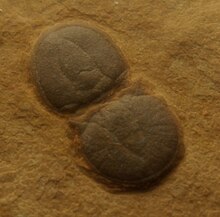Ptychagnostus
| Ptychagnostus Temporal range:
| |
|---|---|

| |
| Ptychagnostus germanus | |
| Scientific classification | |
| Domain: | Eukaryota |
| Kingdom: | Animalia |
| Phylum: | Arthropoda |
| Class: | †Trilobita (?) |
| Order: | †Agnostida |
| Family: | †Ptychagnostidae |
| Genus: | †Ptychagnostus Jaekel, 1909 |
| Synonyms[1] | |
| |
Ptychagnostus is a member of the agnostida that lived during the Cambrian period. Ptychagnostidae generally do not exceed one centimetre in length.[1] Their remains are rarely found in empty tubes of the polychaete worm Selkirkia.[2] The genus probably ranged throughout the water column. It has two glabellar lobes, and three pygidial lobes.[3]
Type species
[edit]Agnostus punctuosus Angelin, 1851 from the Pt. punctuosus Zone of the Alum Shale (Drumian), Sweden (by original designation). Official ruling on the conservation of accepted usage of A. punctuosus as the type species was given by the International Commission on Zoological Nomenclature, 1993.
Remarks
[edit]Ptychagnostus affinis (Brøgger 1878) [4] was once considered a subspecies of Pt. punctuosus. Laurie (2008) [5] grouped punctuosus and affinis within Ptychagnostus, but preferred to place the closely related atavus within Acidusus.
Ptychagnostidae Genera
[edit]Høyberget & Bruton (2008) [6] concluded that the following genera belong in the Ptychagnostidae: Ptychagnostus, Goniagnostus, Tomagnostus, Lejopyge, Aotagnostus and Onymagnostus.
Species
[edit]- Ptychagnostus punctuosus (Type species).
- Ptychagnostus affinis (formerly Pt. punctuosus affinis)
- Ptychagnostus aculeatus
- Ptychagnostus akanthodes
- Ptychagnostus atavus
- Ptychagnostus cassis
- Ptychagnostus ciceroides
- Ptychagnostus cuyanus
- Ptychagnostus germanus
- Ptychagnostus gibbus
- Ptychagnostus hybridus
- Ptychagnostus intermedius
- Ptychagnostus michaeli
- Ptychagnostus praecurrens
- Ptychagnostus seminula
References
[edit]- ^ a b Samuel M. Gon III. "Agnostida Fact Sheet". A Guide to the Orders of Trilobites. Retrieved 18 November 2012.
- ^ Brian D. E. Chatterton, Desmond H. Collins & Rolf Ludvigsen (2003). "Cryptic behaviour in trilobites: Cambrian and Silurian examples from Canada, and other related occurrences". In Philip D. Lane, Derek J. Siveter & Richard A. Fortey (ed.). Trilobites and their Relatives: contributions from the third international conference, Oxford 2001. Special Papers in Palaeontology. Vol. 70. pp. 157–173. ISBN 978-0-901702-81-4.
- ^ Coppold, Murray and Wayne Powell (2006). A Geoscience Guide to the Burgess Shale, p.56. The Burgess Shale Geoscience Foundation, Field, British Columbia. ISBN 0-9780132-0-4.
- ^ BRØGGER W. C. 1878. Om paradoxides-skifrene ved Krekling. Nyt Magazin for Naturvidens-kaberne 24, 18–88.
- ^ LAURIE J. R. 2008. Species relationships in the Ptychagnostidae (Cambrian, Agnostina). In: Ra´bano I., Gozalo R. & GarciaBellido D. eds. Advances in trilobite research, pp. 211–218. Cuadernos del Museo Geominero 9.
- ^ HØYBERGET M. & BRUTON D. L. 2008. Middle Cambrian trilobites of the suborders Agnostina and Eodiscina from the Oslo Region, Norway. Palaeontographica A286, 1–87.
External links
[edit]- "Ptychagnostus praecurrens". Burgess Shale Fossil Gallery. Virtual Museum of Canada. 2011. Archived from the original on 2020-11-12. Retrieved 2023-01-21.
 Media related to Ptychagnostus at Wikimedia Commons
Media related to Ptychagnostus at Wikimedia Commons
